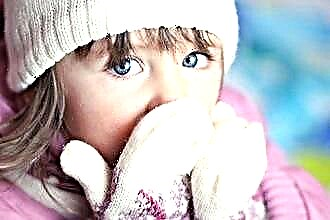Often, when visiting preschool (kindergartens) and school institutions, the child's parents note the appearance of rhinitis several times a year. How to quickly heal the child and return to the educational team? Some of the tips in this article will help answer these questions.
 A runny nose in children is always a symptom of the underlying disease, ranging from a common cold, allergies, foreign bodies entering the nasal passages, ending with a viral infection or a residual phenomenon of past bacterial diseases. It is undesirable to immediately heal a runny nose. But it is extremely dangerous not to pay any attention to rhinitis and its symptoms. This can lead to complications (sinusitis, otitis media, tonsillitis (sore throat), pharyngitis). The exception is the so-called "physiological rhinitis", which can be observed in children up to 2 - 2.5 months.
A runny nose in children is always a symptom of the underlying disease, ranging from a common cold, allergies, foreign bodies entering the nasal passages, ending with a viral infection or a residual phenomenon of past bacterial diseases. It is undesirable to immediately heal a runny nose. But it is extremely dangerous not to pay any attention to rhinitis and its symptoms. This can lead to complications (sinusitis, otitis media, tonsillitis (sore throat), pharyngitis). The exception is the so-called "physiological rhinitis", which can be observed in children up to 2 - 2.5 months.
During this period, the compensatory mechanisms of the nasal analyzer and its mucous structure are triggered and regulated. Often this type of rhinitis does not require intervention and goes away without treatment.
It is enough to maintain the correct microclimate in the child's room. Sometimes pediatricians recommend instilling 2 to 3 drops of breast milk into the child's nose several times as a treatment. During this period, it is rich in immune bodies. If the process aggravates (more than 3 - 5 days), you should contact your pediatrician.
Rhinitis (runny nose) symptoms:
- nasal congestion due to swelling of the nasal mucosa;
- dryness and burning in the nose;
- the release of serous - catarrhal exudate, eventually turning into a more turbid and viscous;
- sneezing;
- sometimes headache.
The manifestation of the above signs is accompanied by a general discomfort in the child.
Kalanchoe and its medicinal properties
Folk remedies should be used for colds in children only after the recommendation of a doctor and with extreme caution. According to the children's otolaryngologist Victoria Segal, some phytoncides (onion juice, beets) can only aggravate the condition of an already inflamed mucous membrane, up to a slight chemical burn.
The concentrated solution reduces (inhibits) the motor ability of the epithelium and leads to spasm of mucous cells. The elimination of pathogenic microorganisms is suspended. The same applies to the use of concentrated Kalanchoe juice. But on the recommendation of a pediatrician (after examining the mucous membrane) and with proper dilution, you can occasionally use Kalanchoe and its medicinal properties for children with a runny nose.
 More than two hundred species of Kalanchoe are known, but only two of its types have found medical application. In our climatic zone, the plant does not occur in nature, but it is successfully grown as an indoor plant, without losing its medicinal properties. The main property due to which Kalanchoe juice is used for a cold in children is its ability to cause a reflex reaction - sneezing. Thanks to him, the nasal canal is freed from the accumulated mucus. Kalanchoe juice is applicable in combination with pharmaceutical nasal drugs. The only condition will be compliance with a break between the use of funds in 10 - 15 minutes.
More than two hundred species of Kalanchoe are known, but only two of its types have found medical application. In our climatic zone, the plant does not occur in nature, but it is successfully grown as an indoor plant, without losing its medicinal properties. The main property due to which Kalanchoe juice is used for a cold in children is its ability to cause a reflex reaction - sneezing. Thanks to him, the nasal canal is freed from the accumulated mucus. Kalanchoe juice is applicable in combination with pharmaceutical nasal drugs. The only condition will be compliance with a break between the use of funds in 10 - 15 minutes.
The healing properties of Kalanchoe have the following actions:
- immunomodulatory;
- anti-inflammatory;
- decongestant;
- antimicrobial;
- regenerating (wound healing);
- antihemorrhagic (stops bleeding).
For all its useful properties, the plant requires caution in its use, especially when treating children. It is advisable to use the juice of a three-year Kalanchoe, although younger plants are also healing.
A child should use Kalanchoe for a cold not at the onset of the disease, but only after a few days, when obvious complications become visible. Allow the body to try to cope with the symptom on its own. During this period, you can rinse the nose with saline or pharmaceutical preparations - "Aquamaris", "Salin", "Physiomer".
Kalanchoe leaves are used to prepare the medicine at home. It is used to prepare:
- broth;
- fresh juice.
The broth is used for babies (1 - 3 months). The effect of the broth is very mild, one might say weak, but quite sufficient to induce sneezing.
The recipe for the decoction and how to drip Kalanchoe into the child's nose: two or three leaves, previously broken into several parts, pour 100 ml of cold water. Bring to a boil and cool (the infusion process will take 30 - 40 minutes). Apply a solution at room temperature. It is enough to drip 2 - 3 drops of the medicine, after which, after 10 - 15 seconds, the child will sneeze several times. Mom only needs to use a cotton pad to remove the secreted mucus in time.
For older children, fresh juice from the leaves of the plant is used. If it is juicy, it is enough to squeeze the leaves with your fingers through cheesecloth or bandage. With their dryness and lethargy - rub the sheet on a grater and squeeze the gruel.

The principles of instilling a decoction or freshly squeezed Kalanchoe juice with a cold in children are identical to the generally accepted method of instilling drugs: 2 - 4 drops in each nostril, depending on the child's age. It is only necessary to remember: the juice of Kalanchoe in the nose for children should be used in dilution with boiled water in order to avoid an allergic reaction and burns of the nasal mucosa in a ratio of 1: 2 or 1: 3 (one part of juice for two to three parts of water).
Children should bury Kalanchoe from a cold as needed. Typically, treatment is given three times a day. There are recommendations of traditional medicine to combine Kalanchoe juice with onion juice, aloe. In order to avoid undesirable consequences, pediatricians recommend abandoning these recipes and are condescending to monotherapy with Kalanchoe.
The squeezed Kalanchoe juice should be stored in a cool place (refrigerator, but not in the freezer) for no more than three days.
Before using, the drops in the bottle should be slightly warmed up in the palms of your hands or warm water. If there are enough leaves, it is advisable to prepare fresh juice, albeit a little, but fresh daily. After applying Kalanchoe and stopping sneezing, you should carefully blow out (if the child can) alternately each nostril in order to avoid excessive pressure on the Eustachian tube.
Also, observance of some rules will help get rid of a cold:
- Regularly between instillation of Kalanchoe into the nose of children, carry out additional moistening of the mucous membrane with saline.
- Humidify the indoor air, especially during the heating season.
- Together with your child, study the active points of the foot, which are reflexively connected to the nasal mucosa. Both interesting and useful.
- Practice massaging your feet and then wrapping them in warm socks.
If you feel good (at normal body temperature and no sweating), move more with your child: ride a bike, play ball, do exercises.

Basic principles of treatment
When treating a common cold in children, you need to remember a few rules:
- Before starting treatment for rhinitis, the cause of it should be clearly identified.
- Start therapy not with the use of medications, but with rinsing and moistening the nose with aqueous solutions, cleaning it.
- To bury Kalanchoe juice with a runny nose in children should be on the 3rd - 5th day of the onset of the symptom.
- Do not use the medication for more than 7 days to avoid allergies. The selection of another drug is possible.
- Do not warm up the baby's nose - this will increase the swelling and aggravate the general condition.
Enrich the child's diet with vitamin C, carotene (cabbage, onion, parsley, celery, black currant, lemon).If the child is an infant, consult about the mother's intake of preparations containing a vitamin - mineral complex.
Provide children with daily walks in the fresh air (does not apply to acute and viral diseases with a violation of the temperature regime). Increase the frequency of feeding or drinking (brew rose hips).
Remember, a runny nose is often a symptom of an underlying medical condition. You need to treat the whole body in a comprehensive manner. Do not forget to improve the immune status of the child's body. Lead an active lifestyle, temper the whole family and be healthy.



